 |
||
|
||
| ||
Many companies currently offer various series of coolers for Intel and AMD. In this article we'll try to compare coolers for these platforms irregardless of an intended processor type. That is they will be tested in absolutely equal conditions so that we can compare their thermal, aerodynamical, and noise characteristics by our procedures directly on the same heat-generating platform. Foxconn CoolersThe first cooler, Foxconn NBT-CMI775-4B (Foxconn-1), is designed for Intel Pentium 4 (Prescott) LGA775 2.8-4.0 GHz and Celeron D LGA 775. It has a round aluminum heatsink with a copper core. Nominal rotational speed of the 90mm fan is 2500 rpm.  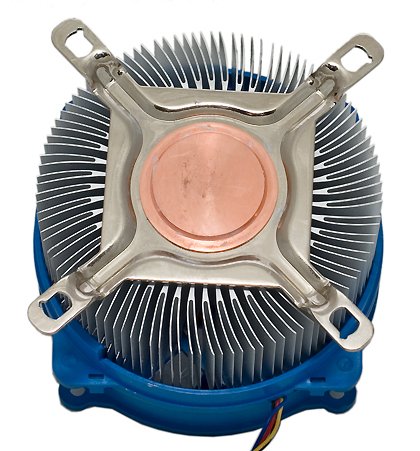 The heatsink is of an interesting design. Its fins are bent counter to fan rotation and have a fork shape. It's a single fin in the center, which then forks. This curve can be probably explained by designers' wish to make the air flow from the powerful fan as axial as possible. That is they created sort of a nozzle block, widely used in impeller machines. It must provide axial air flow - along the entire fin height instead of going out at the top of the heatsink. Our aerodynamic measurements confirm it. The air starts exiting at the sides of the heatsink only from the middle of its height. The air speed at the lower sides is 0.7-0.9 m/s. The main air flow exits at the lower face of the heatsink at 0.9-1.1 m/s. That is we can assert that most of the air cools the entire surface of fins in the heatsink. But this design also has negative issues. They are an increased pressure loss and noise of the cooler. Air flow speed inside the heatsink is probably rather low, despite a more or less powerful fan. That's why the heat exchange ratio in this heatsink is not high. We shall speak about noise below. The second cooler, Foxconn NBT-CMA-R8-2S (Foxconn-2),is designed for AMD Opteron and Athlon 64/Fx. It has a classic rectangular heatsink with a copper core. Fan speed is 2000 rpm. Fan diameter - 77 mm. 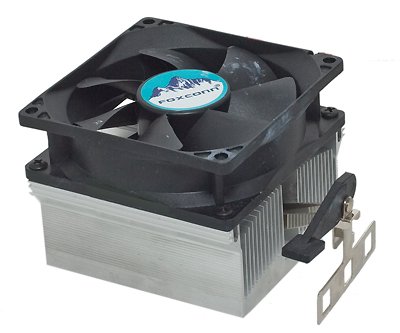 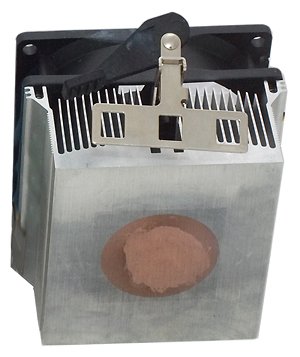
Foxconn NBT-CMA-R8-2S seems to be weaker than the previous model in its parameters. The air exits from the heatsink only at two short sides. Air flow speed in the upper part of finning is 0.6-0.8 m/s. In mid and low sections - 1.2-1.4 m/s. On the whole, it's a tad higher than in the previous model. Gigabyte CoolerLet's review another cooler GH-ED721-MF (Neon Cooler 7Pro) from Gigabyte, also designed for AMD Athlon 64 and all Semprons. The fan offers variable rotational speed. The bundle includes a fan speed control module for a PCI slot, which varies fan speed from 1700 to 3400 rpm. Design of this heatsink is similar to Foxconn NBT-CMA-R8-2S. 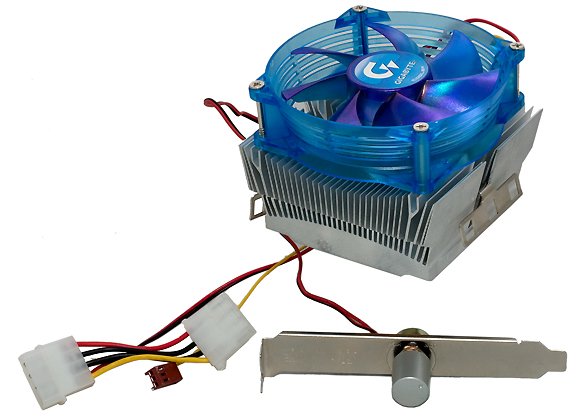 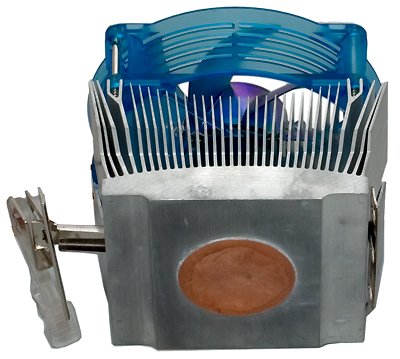
In fact, the shape of this heatsink is a tad different. Its cross-section is trapezoid with the long size on top instead of rectangular in Foxconn. That is the air flow speeds up towards the base. The cooler is equipped with four LEDs, so it shines as a flash-light. The air exits finning a tad faster than in Foxconn-2. From the upper section at maximum fan speed - 0.6-0.8 m/s, from the mid section - 1.6-1.8 m/s, from the lower section - 1.4-1.8 m/s. That is we can expect this cooler to work more efficiently than Foxconn-2. We'll have the following air flow speeds at minimum fan speed - 0.4-0.6 m/s, 1.2-1.4 m/s, and 1.0-1.2 m/s. This situation is similar to Foxconn-2. The engineers assert that it offers a high degree of air flow and noise-reduction design of the heatsink, that is it possesses "optimum design for balancing performance and acoustic." As we can see, there are some aerodynamical improvements. Now let's see what happened to thermal characteristics. We have conducted thermal tests by the procedure, described here. We measured platform temperature without a cooler, with cooler (fan disabled), and with cooler (fan enabled). We applied 100 Watts to the platform in maximum mode. But of course, some heat was dissipated, though a tad less than in a real computer. You can see the readings on the following graph. Platform temperature. Maximum mode.
Temperature: 1.Without a cooler; 2.With a heatsink. 3.With a cooler
The heatsink in Foxconn-2 is much less efficient with its fan disabled. Heatsinks in Foxconn-1 and Gigabyte are on a par. But their heat exchange surface area is larger. These coolers also possess unquestionable advantage with enabled fans. That actually comes from their aerodynamical characteristics. Results of the Gigabyte cooler are published for the maximum fan speed. At minimum fan speed, the platform temperature grows by 5-7 degrees. The same readings for the moderate mode are published on the next graph. Platform temperature. Moderate mode.
Temperature: 1.Without a cooler; 2.With a heatsink. 3.With a cooler
The tendency remains. On the whole, the heatsink and the Foxconn-2 itself works worse than the other two models, they are practically identical. We can say that the cooler from Foxconn for the Intel platform is thermally better than that for AMD. Though the Gigabyte model for AMD at maximum fan speed is no worse than Foxconn for Intel. But that's not all, of course. Noise characteristics are also very important. We don't plug our ears and disregard PC noise now. Of course, you wouldn't like sitting with cottonwool in your ears for several hours. Some people have stable mentality or hearing defects, so that they are not bothered by 40 dBA noise. But such people are few, so companies are quite right to reduce noise even at the cost of worse thermal characteristics of coolers. We measured noise characteristics using the equipment and procedures described here. A relative noise level of Foxconn coolers is 31.7 dBA for the first model and 23 dBA for the second one. Though according to the specifications, the maximum relative noise of the first model must be 28 dBA, 21 dBA in the second model. But in fact these coolers are noisier than their engineers planned. The noise spectrum is published below.  Y axis - Sound pressure level, dB; X axis - Frequency, Hz Noise level of the first cooler is determined by the frequency band, where noise is generated by the blading spectral component, that is by rotation of a fan. But it's weakened, because ear sensitivity drops at low frequencies. In case of the second model, the noise is generated by the air flow in the heatsink. Relative noise level of the Gigabyte cooler at minimum fan speed is 16.5 dBA. That is it is practically inaudible by ear. But the noise level grows to 35.3 dBA at maximum fan speed. Let's have a look at the noise spectrum. 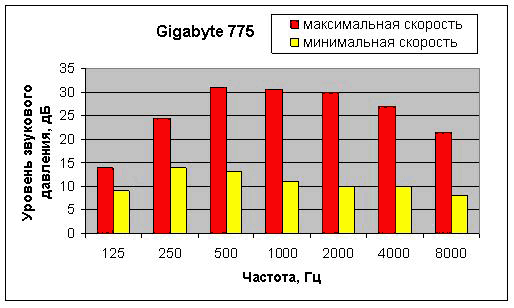 Y axis - Sound pressure level, dB; X axis - Frequency, Hz; Red - max. speed; Yellow - min. speed The main contribution to the noise level at a high rotational speed is made by the air flow through the heatsink. Contribution of the component frequency, determined by the fan speed, is low. On the whole, we can see a proof to the rule - the larger a cooler is, the better it cools. But thanks to the fan speed control, Gigabyte cooler has a definite advantage. You can select a reasonable compromise between noise and heat efficiency. AVC CoolersLet's review two coolers from AVC. The first model, Z9M700Z1, is designed for Intel Pentium 4 (Prescott) and Celeron D processors for LGA 775 up to 3.2 GHz. It has a round aluminum heatsink with a copper core. Fan speed is 3600 rpm. Its diameter is 90 mm. Blade-shaped fins of the heatsink are curved counter-fan-wise like in a similar model from Foxconn. But they are of invariable thickness here.  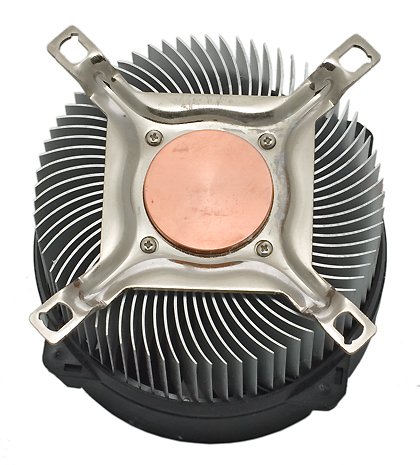
Air flow speed at the side is 0.4-0.6 m/s. Velocity profile around the heatsink is practically even. The air speed at the end face amounts to 1.2-1.4 m/s. It's an indirect sign that most of the air cools the entire finning surface. The second cooler, AVC Z7UB003003, is designed for AMD Athlon 64, Sempron 3100+, Opteron for Socket 754/939. Fan size - 70õ70õ25mm. Its rotational speed according to the specifications is 5400 rpm. We sensed something off-key about this figure. So we measured the rotational speed in a computer and compared it to the signal frequency from the photodiode registering light from fan blades. The photodiode was connected to mic-in of a sound card. Alas, it turned out to be 3000 rpm. Perhaps it was only our sample, but the fact remains. The heatsink is made of aluminum with a copper insert. Its design is significantly different from the other coolers of the same type. Namely, the cooling air exits not only at the sides, but also at the end face. That is the base is not solid and the air can go directly through the heatsink. 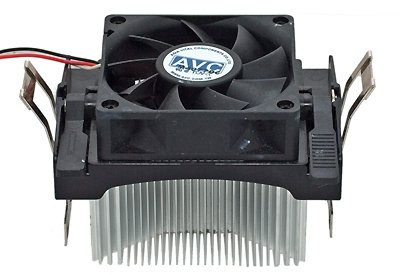 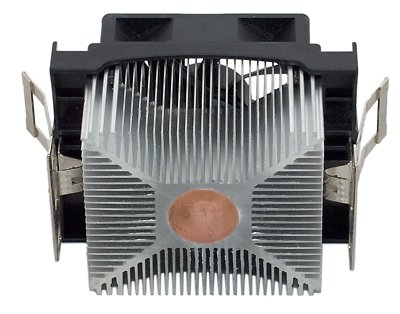 All other things being equal, the heat transfer rate is higher for transverse air flow than for longitudinal air flow. That's a disadvantage of this design. But we have increased heat exchange surface area as well as reduced pressure loss of the cooler. That's an evident advantage. Later on we'll check out which trait will have a greater effect. Aerodynamical measurements revealed high nonuniformity of the velocity profile, both at the end face as well as at the sides of the heatsink. Maximum air flow at the sides was 1.2-1.4 m/s. That is on the whole, we can hope that this cooler will work well and this heatsink design (let's call it straight-flow) will justify itself. Let's carry out thermal tests and check up our assumptions. Experiment conditions remained the same. We publish temperature readings of the platform in maximum mode below. Platform temperature. Maximum mode.
Temperature: 1.Without a cooler; 2.With a heatsink. 3.With a cooler
The graph shows that the heatsink of the second cooler offers nothing special. On the contrary, its temperature is higher by more than 40 degrees than in AVC-Z9M. But when we enable the fan, this difference goes down to 20 degrees. Now let's have a look at the moderate mode. Platform temperature. Moderate mode.
Temperature: 1.Without a cooler; 2.With a heatsink. 3.With a cooler
The tendency remains, though the relative difference is a tad smaller. Pay attention to a low temperature level of the platforms with fully functional coolers - not only in moderate mode, but also in maximum mode. Temperature of the AVC-Z9M platform even in maximum mode is below 60 degrees. You will hardly have problems with CPU overheating. On the whole, AVC-Z7U also fairs well. As usual, the problem of noise in these coolers remains. Our measurements of sound pressure level in octave bands are published in the picture below. 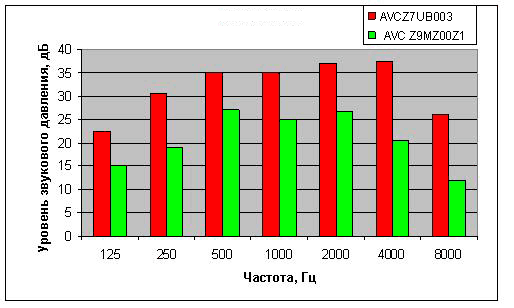 Y axis - Sound pressure level, dB; X axis - Frequency, Hz A noise level is determined mostly by the air flow through the heatsinks. Relative noise level of the AVC-Z9M is 41.5 dBA - that's too much. You can keep your patience for an hour. But if you have to listen to it all the time, you may go into a frenzy. That depends on a user, of course. By the way, the official noise level was even higher — 45.5 dBA. In case of the AVC-Z7U cooler, the noise level is 30 dBA. It's much lower than in the previous model, but it's not all honey either. Here you can actually reach a compromise between cooling efficiency and a noise level. That is these models still have the old problems. The only way out so far is to use a fan speed control unit. Comparing Coolers for Intel and AMDNow let's have a look at the efficiency of coolers for the same platform, but from different manufacturers. Intel platform: NBT-CMI775-4B from Foxconn (Foxc-1) and AVC-Z9M700Z1 (AVC-Z9M). Both have round shaped heatsinks, described above. Let's also recall the previously reviewed cooler with a round heatsink and a copper core - ICE HAMMER. 
Thermal characteristics of these coolers in maximum mode are published below. Platform temperature. Maximum mode.
Temperature: 1.Without a cooler; 2.With a heatsink. 3.With a cooler
The diagram shows that the most efficient heatsink is installed in the AVC cooler, Foxconn's heatsink is a tad worse, even though its fins have a more complex and technologically more labor-intensive fork-like configuration. ICE HAMMER's heatsink brings up the rear, though the difference is not that high. This tendency remains even when we enable the fan. But enabling a fan in ICE HAMMER decreases the temperature by 53 degrees, by 60 degrees in the other two models. That is their fans are more efficient. In the moderate mode the tendency remains. Platform temperature. Moderate mode.
Temperature: 1.Without a cooler; 2.With a heatsink. 3.With a cooler
We didn't took readings of ICE HAMMER in this mode. Thus, AVC and Foxconn coolers are very close in thermal terms, though the former model is a tad better. Both of them keep the platform temperature below 70 degrees, even in maximum mode. But the noise difference is significant. 41.5 dBA in AVC versus 31.5 dBA in Foxconn. That is, if your processor always works at maximum capacity, a cooler with a platform temperature lower by several degrees can save your CPU from overheating. But even in these extreme conditions noise characteristics still play an important role. It should be noted, the higher is CPU power (the higher is the platform temperature in our tests), the higher is the difference in cooling efficiency of our contenders. That is in case of the most powerful processor, AVC coolers keeps the temperature lower by 9 degree than Foxconn. The difference in the moderate mode is just 6 degrees. Let's carry out the same comparison for AMD coolers. Let's add another cooler to our contenders AVC-7ZUB003003 (AVC-Z7U), Foxconn CMA K8-2S (FOXC-2) and Gigabyte GH-ED721-MF - Titan Siberia, which faired well in our previous reviews. 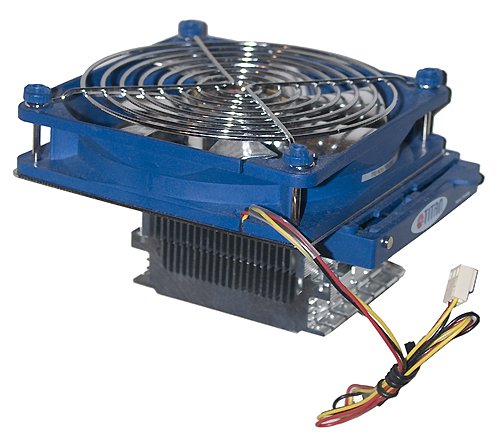
All of them have rectangular heatsinks, though differently shaped. The diagram for the maximum mode is published below. Platform temperature. Maximum mode.
Temperature: 1.Without a cooler; 2.With a heatsink. 3.With a cooler
The best heatsink in this mode is from the Gigabyte model. Titan Siberia's heatsink is tad worse. AVC and Foxconn coolers keep the platform temperature at a noticeably higher level. These tendencies remain, when we enable fans. But AVC results got much better. That is the straight-flow design of a heatsink improves cooling efficiency - we have already mentioned it above. It's much higher than in Foxconn. The same situation can be seen in the moderate mode. Platform temperature. Moderate mode.
Temperature: 1.Without a cooler; 2.With a heatsink. 3.With a cooler
But the Foxconn cooler is noticeably outperformed again. It should be stressed that Gigabyte and Titan Siberia coolers are equipped with a fan speed control module, which allows to change it nearly twofold. The data for these coolers published above correspond to the maximum fan speed. At minimum fan speed, platform temperature grows by 6-8 degrees and practically touches in AVC results. But what's important, noise characteristics become twice as low and reach 16.5 dBA (Gigabyte cooler) compared to 35.3 dBA at maximum rotational speed. This relative noise level is practically inaudible. Such a module is indeed a unique opportunity to vary efficiency of the cooler for various CPU power capacities. Reducing the platform temperature even by several degrees may prevent CPU overheating under maximum load. And the noise advantage is more than evident. By the way, I think that it's easy and cheap to implement automatic rpm control depending on the CPU core temperature. Note that any fault during the cooler installation is critical. It may result in a significant reduction of thermal efficiency. To clear up this issue, let's publish mechanical, thermal, and noise characteristics in a table. Thermal characteristics are published for the maximum mode.
As you can see in the table, design of a heatsink has a noticeable effect on the cooling efficiency. If a fan is disabled, it all comes down to the heat exchange surface area of a heatsink. That's why round coolers from AVC and Foxconn are victorious in our case. The heatsink in the Gigabyte cooler also fairs well. But when engineers design heatsinks for systems with a forced air flow, like our coolers, they often forget about one important nuance. Namely, about the pressure loss of the air duct. In attempt to increase heat exchange surface area as much as possible, they leave too narrow slits between thin long fins. That has a negative effect on a fan. Roughly speaking, it cannot push lots of cool air through the system. By the way, output characteristics of fans in cooler specifications are often, if not always, published for the idle mode, that is ignoring the heatsink resistance. All these issues certainly require a more thorough examination, but that's up to designers. So the speed of a cooling air flow in inter-fin space in all our heatsinks does not exceed 2 m/s. It generally amounts to 1—1.2 m/s in coolers with highly developed surface area. It does not allow to reach high rates of heat exchange, we already spoke about it before. But it may suffice at this stage of cooler development. You can see in the table that the most efficient fans are installed in coolers with simple heatsinks. It particularly concerns the AVC-Z7U cooler, which fan has the strongest effect on platform temperature. Gigabyte and Titan Siberia coolers with a fan speed control unit are significantly advantaged. A relative noise level of a cooler is not directly proportional to the rotational speed of a fan. That's clear. It depends on aerodynamical noise (which has to do with detached air flows in fan's blading as well as in a heatsink) rather than on mechanical noise of a bearing. Curved counter-fan-wise fins in Intel coolers may generate additional noise in the slit between a fan and a heatsink. What concerns retail prices for these coolers, they are actually on the same level. Foxconn coolers are a tad cheaper than AVC coolers. Without any apparent reasons. The cheapest cooler is Foxconn NBT-CMA-K8-2S, but it is also the least efficient. Interestingly, prices for coolers with a fan speed control unit are practically the same. On the whole, the situation with these various coolers is clear. The higher is the thermal efficiency, the higher is the relative noise level of a cooler. Of course, we can introduce some universal criterion to bind these values, like in this article. But it's hard to tell how well posed it is to bring purely technical aspects (directly connected to PC operation) into correlation with noise perception. Noise is perceived by people differently and it will not damage your computer. But your health is above all. To all appearances, you should choose a cooler proceeding from your specific tasks rather than general ideas. In the light of the above said, fan speed control looks very attractive. Alexander Tsikulin (tcik2000@mail.ru)
Noise characteristics: Alexei Gladilin (hfus@mail.ru) Albert Dogadov (dogadov@akin.ru)Engineering support: Ivan Muratov (imur77@mail.ru) April 4, 2006 Write a comment below. No registration needed!
|
Platform · Video · Multimedia · Mobile · Other || About us & Privacy policy · Twitter · Facebook Copyright © Byrds Research & Publishing, Ltd., 1997–2011. All rights reserved. | |||||||||||||||||||||||||||||||||||||||||||||||||||||||||||||||||||||||||||||||||||||||||||||||||||||||||||||||||||